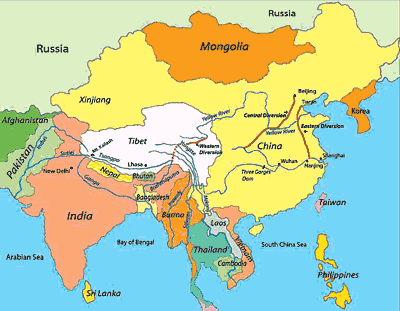From the ever-wonderful Dark Roasted Blend, a series of photos from the Himalayas (example above). Truly vertiginous, and reminds me of a series I watched about truckers who work in Alaska going for a busman's holiday along some of the world's other deadly routes. Plus Welsh comedian Rhod Gilbert and Greg Davies going through Nepal and literally up to the gates of China.
One of the things that make these areas so dangerous is that they are ever-decaying. In his 1958 travel book, A Short Walk In The Hindu Kush, Eric Newby describes a constant clattering of pebbles and rocks from the high places above.
But The Himalayas are still rising as the Indian subcontinent continues to crash into the Eurasian landmass, and the snowfields that created in Tibet gave rise to the great rivers that flow through and feed South-East Asia: the Indus, Sutlej, Ganges and Brahmaputra. I've often wanted to do the a sort of pilgrimage to that area, which in fact is an ancient site of worship centring on Mount Kailash.
The Himalayan range is young in geological terms, beginning about 65 million years ago - coincidentally around the time the dinosaurs died out. If only we could live long enough, and perceive slowly enough, to see the wandering of the continents about the globe:
And what of the future?:
Mountains are life-givers: without them, much less chance of rain and the fresh water that sustains us.
There is debate about how high a mountain can possibly be. The tallest from root to tip is Mauna Kea in Hawaii, but 60% of that is below the waves. The highest in the Solar System is on Mars and is some 72,000 feet - but that is in Mars' much lower gravity. This commentator says the theoretical limit on Earth is 90,000 feet, or about four times the height of Everest - but I think from what he says that you would have to include the depth of the tectonic plate on which the mountain stands.
Nevertheless, if the Tower of Babel had been completed and constructed as strongly as a mountain, it should easily have got among and even above high-level clouds. Breughel was right:
If the Babylonians had had the EU's translation facilities of Brussels or Strasbourg, they could have finished the building. Who knows what it would have looked like?
However, they tried to make it of brick, which in even the modern version of the material apparently can't make a wall higher than some 840 feet.
Mudbrick structures in Shibam, Yemen go up to nearly 100 feet; the Burj Khalifa in Dubai tops out at 2,717 feet; but the theoretical maximum is 10 - 100 kilometres.
It's even been suggested (see "technobot" comment #7 here) that a structure made out of diamond could stand 6-12,000 km high (they could get the material from this diamond star, I guess). Though there remains the question of economic rationale - whay you'd need to compress that much rentable space onto that base, and who could afford it (bearing in mind that land costs would be dwarfed by the expense of materials and labour).
And would any of them have the beauty of the real thing in Nature?




No comments:
Post a Comment